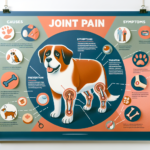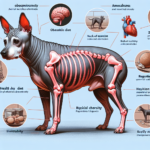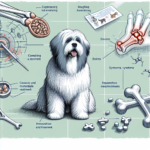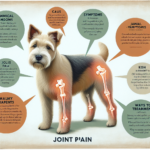Hamiltonstovare Joint Pain: Causes, Symptoms, Prevention, and Treatment

Introduction
The Hamiltonstovare, also known as the Hamilton Hound, is a breed of dog that originated in Sweden. Named after Count Adolf Hamilton, the founder of the Swedish Kennel Club, this breed was developed in the late 19th century by crossing English Foxhounds, Harriers, and various German hounds. The Hamiltonstovare is known for its keen sense of smell, endurance, and agility, making it an excellent hunting dog, particularly for tracking and hunting hares and foxes. Characterized by its tricolor coat, muscular build, and friendly disposition, the Hamiltonstovare is not only a skilled working dog but also a loyal family companion.
Like many breeds, the Hamiltonstovare is prone to certain health issues, with joint pain being a significant concern. Joint health is crucial for this breed due to its active lifestyle and the physical demands placed on its body during hunting and other activities. Understanding the causes, symptoms, prevention, and treatment of joint pain in Hamiltonstovares is essential for ensuring their well-being and maintaining their quality of life.
Breed-Specific Joint Pain Risks
Genetic Predisposition
The Hamiltonstovare, like many other breeds, has a genetic predisposition to joint-related issues. Common conditions include hip dysplasia, elbow dysplasia, and arthritis. Hip dysplasia is a hereditary condition where the hip joint does not fit properly into the hip socket, leading to pain and mobility issues. Elbow dysplasia involves abnormal development of the elbow joint, causing lameness and discomfort. Arthritis, a degenerative joint disease, can also affect Hamiltonstovares, leading to chronic pain and stiffness.
Age-Related Risks
As Hamiltonstovares age, the risk of developing joint pain increases. The breed typically begins to show signs of joint issues around middle age, which is approximately 5-7 years old. However, some dogs may develop symptoms earlier or later, depending on their genetic makeup and lifestyle. It is essential for owners to monitor their dogs for any signs of joint pain as they age and to take preventive measures to maintain joint health.
Activity Level and Joint Stress
The Hamiltonstovare is an active and energetic breed, often used for hunting and other physically demanding activities. This high activity level can contribute to joint stress and exacerbate existing joint issues. Repetitive motions, such as running and jumping, can put additional strain on the joints, leading to wear and tear over time. It is crucial for owners to balance their dog’s activity level with appropriate rest and recovery periods to minimize joint stress.
Common Symptoms of Joint Pain in Hamiltonstovare
General Symptoms
Owners should be vigilant for common symptoms of joint pain in their Hamiltonstovare, including:
- Limping or favoring one leg
- Stiffness, especially after rest or exercise
- Reluctance to move, jump, or climb stairs
- Decreased activity level or interest in play
- Swelling or heat around the joints
- Whining or showing signs of discomfort when touched
Breed-Specific Symptoms
In Hamiltonstovares, joint pain may manifest in specific ways due to their unique physical characteristics and activity levels. For example, they may show a noticeable decrease in their hunting or tracking abilities, or they may become less enthusiastic about outdoor activities. Additionally, their muscular build may mask early signs of joint pain, making it essential for owners to pay close attention to subtle changes in behavior and movement.
When to Consult a Vet
If an owner notices any of the above symptoms in their Hamiltonstovare, it is crucial to consult a veterinarian promptly. Early diagnosis and intervention can help manage joint pain more effectively and prevent further deterioration. A veterinarian can perform a thorough examination, including physical assessments and imaging tests, to determine the underlying cause of the joint pain and recommend appropriate treatment options.
Preventive Measures for Joint Health
Exercise Recommendations
Regular exercise is essential for maintaining joint health in Hamiltonstovares, but it is important to choose activities that minimize joint stress. Low-impact exercises, such as swimming and walking on soft surfaces, are ideal for this breed. Owners should avoid high-impact activities like excessive running or jumping, especially on hard surfaces. Consistent, moderate exercise helps maintain muscle strength and joint flexibility without overloading the joints.
Dietary Suggestions
A balanced diet rich in essential nutrients can support joint health in Hamiltonstovares. Owners should consider feeding their dogs high-quality commercial dog food formulated for joint health or incorporating specific supplements into their diet. Key nutrients to look for include:
- Glucosamine and Chondroitin: These supplements help maintain cartilage health and reduce inflammation.
- Omega-3 Fatty Acids: Found in fish oil, these fatty acids have anti-inflammatory properties that can benefit joint health.
- Antioxidants: Vitamins C and E can help reduce oxidative stress and support overall joint health.
Weight Management
Maintaining a healthy weight is crucial for reducing joint stress in Hamiltonstovares. Excess weight puts additional pressure on the joints, exacerbating pain and discomfort. Owners should monitor their dog’s weight and adjust their diet and exercise routine as needed to prevent obesity. Regular veterinary check-ups can help ensure that the dog remains at an optimal weight for their age and activity level.
Early Screening and Monitoring
Early screening and monitoring can help detect joint issues before they become severe. Owners should consider regular veterinary check-ups that include joint assessments, especially as their Hamiltonstovare ages. Additionally, genetic testing can identify predispositions to joint conditions, allowing for early intervention and preventive measures. Monitoring the dog’s movement and behavior for any signs of discomfort can also help catch joint issues early.
Treatment Options for Joint Pain
Non-Surgical Treatments
Non-surgical treatments are often the first line of defense against joint pain in Hamiltonstovares. These may include:
- Medications: Nonsteroidal anti-inflammatory drugs (NSAIDs) can help reduce pain and inflammation. Other medications, such as pain relievers and joint supplements, may also be prescribed.
- Physical Therapy: Physical therapy can improve joint mobility and strengthen the muscles around the joints. Techniques may include massage, stretching, and controlled exercises.
- Lifestyle Adjustments: Modifying the dog’s activity level and providing a comfortable living environment can help manage joint pain. This may include using ramps instead of stairs and providing orthopedic beds.
Surgical Options
If joint pain becomes severe and non-surgical treatments are ineffective, surgical intervention may be necessary. Common surgical options for Hamiltonstovares include:
- Hip Replacement: Total hip replacement can provide significant pain relief and improve mobility for dogs with severe hip dysplasia.
- Arthroscopy: This minimally invasive procedure can diagnose and treat joint issues by removing damaged tissue or repairing joint structures.
- Joint Fusion: In cases of severe arthritis, joint fusion can stabilize the joint and reduce pain by fusing the bones together.
Alternative Therapies
Alternative therapies can complement traditional treatments and provide additional relief for joint pain in Hamiltonstovares. These may include:
- Acupuncture: Acupuncture can help reduce pain and inflammation by stimulating specific points on the body.
- Hydrotherapy: Water-based exercises can improve joint mobility and reduce pain without putting stress on the joints.
- Massage Therapy: Massage can help relax muscles, improve circulation, and reduce joint pain.
Lifestyle and Management Tips
Daily Care Routine
A consistent daily care routine can help manage and alleviate joint pain in Hamiltonstovares. This may include:
- Providing regular, low-impact exercise to maintain joint flexibility and muscle strength.
- Feeding a balanced diet with joint-supporting nutrients and supplements.
- Monitoring the dog’s weight and adjusting their diet and exercise routine as needed.
- Administering any prescribed medications or supplements as directed by the veterinarian.
- Regularly checking for signs of joint pain and consulting the veterinarian if any symptoms arise.
Modifying the Home Environment
Making the home environment more comfortable for a dog suffering from joint pain can significantly improve their quality of life. Consider the following modifications:
- Using ramps or steps to help the dog access furniture or vehicles without jumping.
- Providing orthopedic beds that offer extra support and cushioning for the joints.
- Ensuring that the dog’s living area is free of slippery surfaces that could cause falls or injuries.
- Keeping food and water bowls at a comfortable height to reduce strain on the neck and joints.
Long-Term Management
Long-term management strategies are essential for keeping a Hamiltonstovare active and happy despite joint pain. These may include:
- Continuing regular veterinary check-ups to monitor joint health and adjust treatment plans as needed.
- Maintaining a consistent exercise routine that includes low-impact activities and adequate rest periods.
- Providing ongoing joint-supporting supplements and a balanced diet.
- Implementing any recommended lifestyle adjustments or home modifications to reduce joint stress.
FAQs About Hamiltonstovare and Joint Pain
What are the early signs of joint pain in Hamiltonstovares?
Early signs of joint pain in Hamiltonstovares may include limping, stiffness, reluctance to move, decreased activity level, and signs of discomfort when touched. Owners should monitor their dogs for these symptoms and consult a veterinarian if they notice any changes in behavior or movement.
Can joint pain in Hamiltonstovares be prevented?
While it may not be possible to completely prevent joint pain in Hamiltonstovares, owners can take several preventive measures to reduce the risk. These include providing regular, low-impact exercise, maintaining a healthy weight, feeding a balanced diet with joint-supporting nutrients, and scheduling regular veterinary check-ups for early detection and intervention.
Are there specific exercises that are better for Hamiltonstovares with joint pain?
Yes, low-impact exercises such as swimming and walking on soft surfaces are ideal for Hamiltonstovares with joint pain. These activities help maintain joint flexibility and muscle strength without putting excessive stress on the joints. Owners should avoid high-impact activities like running or jumping on hard surfaces.
What dietary supplements can help support joint health in Hamiltonstovares?
Dietary supplements that can support joint health in Hamiltonstovares include glucosamine, chondroitin, omega-3 fatty acids (found in fish oil), and antioxidants such as vitamins C and E. These supplements can help maintain cartilage health, reduce inflammation, and support overall joint function.
When should I consider surgical options for my Hamiltonstovare’s joint pain?
Surgical options should be considered if non-surgical treatments are ineffective and the dog’s joint pain significantly impacts their quality of life. Common surgical options include hip replacement, arthroscopy, and joint fusion. A veterinarian can help determine the most appropriate surgical intervention based on the dog’s specific condition and overall health.
Conclusion
Joint pain is a significant concern for Hamiltonstovares, given their active lifestyle and genetic predisposition to joint-related issues. By understanding the causes, symptoms, prevention, and treatment options for joint pain, owners can take proactive steps to ensure their dog’s joint health and overall well-being. Regular exercise, a balanced diet, weight management, and early screening are essential preventive measures. If joint pain does develop, a combination of non-surgical treatments, surgical options, and alternative therapies can help manage the condition and improve the dog’s quality of life. By staying vigilant and consulting with a veterinarian regularly, owners can help their Hamiltonstovare lead a happy, active, and pain-free life.




